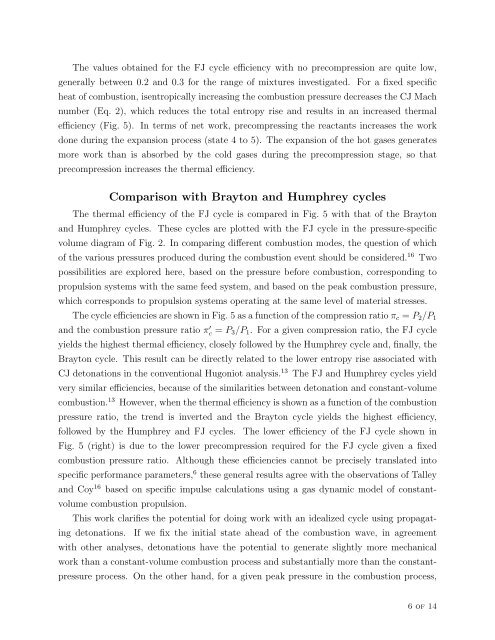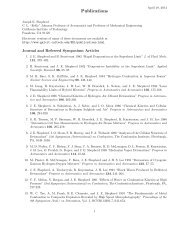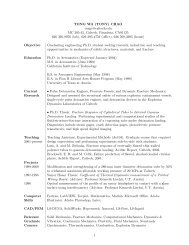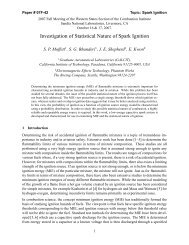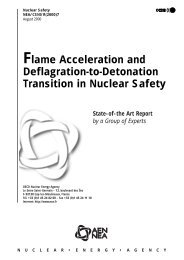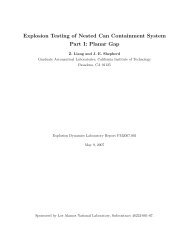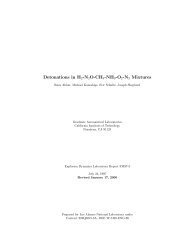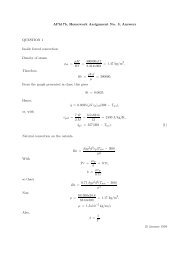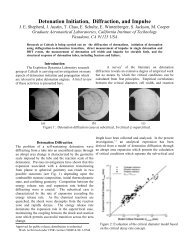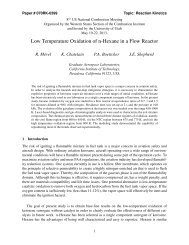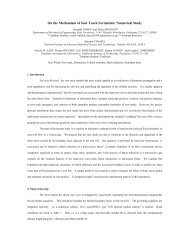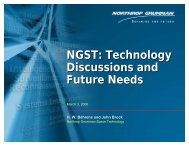Thermodynamic Cycle Analysis for Propagating Detonations
Thermodynamic Cycle Analysis for Propagating Detonations
Thermodynamic Cycle Analysis for Propagating Detonations
You also want an ePaper? Increase the reach of your titles
YUMPU automatically turns print PDFs into web optimized ePapers that Google loves.
The values obtained <strong>for</strong> the FJ cycle efficiency with no precompression are quite low,generally between 0.2 and 0.3 <strong>for</strong> the range of mixtures investigated. For a fixed specificheat of combustion, isentropically increasing the combustion pressure decreases the CJ Machnumber (Eq. 2), which reduces the total entropy rise and results in an increased thermalefficiency (Fig. 5). In terms of net work, precompressing the reactants increases the workdone during the expansion process (state 4 to 5). The expansion of the hot gases generatesmore work than is absorbed by the cold gases during the precompression stage, so thatprecompression increases the thermal efficiency.Comparison with Brayton and Humphrey cyclesThe thermal efficiency of the FJ cycle is compared in Fig. 5 with that of the Braytonand Humphrey cycles. These cycles are plotted with the FJ cycle in the pressure-specificvolume diagram of Fig. 2. In comparing different combustion modes, the question of whichof the various pressures produced during the combustion event should be considered. 16 Twopossibilities are explored here, based on the pressure be<strong>for</strong>e combustion, corresponding topropulsion systems with the same feed system, and based on the peak combustion pressure,which corresponds to propulsion systems operating at the same level of material stresses.The cycle efficiencies are shown in Fig. 5 as a function of the compression ratio π c = P 2 /P 1and the combustion pressure ratio π ′ c = P 3 /P 1 . For a given compression ratio, the FJ cycleyields the highest thermal efficiency, closely followed by the Humphrey cycle and, finally, theBrayton cycle. This result can be directly related to the lower entropy rise associated withCJ detonations in the conventional Hugoniot analysis. 13 The FJ and Humphrey cycles yieldvery similar efficiencies, because of the similarities between detonation and constant-volumecombustion. 13 However, when the thermal efficiency is shown as a function of the combustionpressure ratio, the trend is inverted and the Brayton cycle yields the highest efficiency,followed by the Humphrey and FJ cycles. The lower efficiency of the FJ cycle shown inFig. 5 (right) is due to the lower precompression required <strong>for</strong> the FJ cycle given a fixedcombustion pressure ratio. Although these efficiencies cannot be precisely translated intospecific per<strong>for</strong>mance parameters, 6 these general results agree with the observations of Talleyand Coy 16 based on specific impulse calculations using a gas dynamic model of constantvolumecombustion propulsion.This work clarifies the potential <strong>for</strong> doing work with an idealized cycle using propagatingdetonations.If we fix the initial state ahead of the combustion wave, in agreementwith other analyses, detonations have the potential to generate slightly more mechanicalwork than a constant-volume combustion process and substantially more than the constantpressureprocess. On the other hand, <strong>for</strong> a given peak pressure in the combustion process,6 of 14


